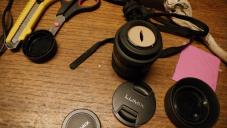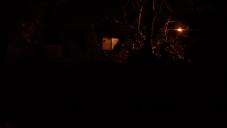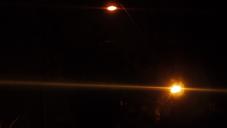
Anamophic lens vs Cinemorph filter
-
I have a Sankor 16c Anamorphic and based on the videos I've seen of the CineMorph, I'll stick with the Sankor. It's a bummer it vignettes at anything under 85mm, but it gives a more genuine Anamorphic look in my opinion.
I did a quick test with the Sankor here. It's not much, but it's a little something:
The anamorphic was mounted to a Canon 18-135mm kit lens I got with the 60D via VidAtlantic clamp. I have since bought a Helios 44m to use with the Sankor, as I heard it was a good, cheap prime to use. And it's definitely a great lens to use both with the Sankor and without, I have had great results for a lens that only cost me about $40! -
i´ll probably make a heart, a star and something else
DIY bokeh shape transformer!! -
hahaha super!
i just love not having to pay to play with this things! -
Ah all right! Well I shall make one myself tomorrow and see how it works... Might make a streak filter too.
-
hahah sorry i dont have a wide angle, sorry :p
-
Ah great! It hit me that the issue was that we have always put it infront of the lens, but on this camera we can do like the real thing and put it on the back!
Could you try it with a wide angle too, just for safety (doubt it will make a difference)? I might make one myself tomorrow, but seeing as you have one prepared. -
hahah here it is a quick test of your idea, it does work
, but i´m lazy, so my oval ain´t that ovalistic
this test was made with cardboard on a canon fd to m/43 adapter with a canond fd 50mm f1.4 attached
(and is a shot of the light reflection on a window with water fog)

 P1010556.JPG4976 x 2800 - 6M
P1010556.JPG4976 x 2800 - 6M
 P1010555.JPG4976 x 2800 - 4M
P1010555.JPG4976 x 2800 - 4M -
I just had the craziest idea, that might and might not work. But the anamorphic bokeh comes from the shape at the back of the lens... So i figured... What if one was to make an anamorphic bokeh shape in the lens adapter?! A lot of M4/3 adapters has a lot of air inside, to make up for the flange distance. That means one would have enough room to mount something like that back inside it, which should mean that it would work on wide angles (or at least in theory) while giving anamorphic bokeh!
-
ps, the flares in the nightshots are not colored, because i forgot to do the white balance, so they were taken with the day white balance
-
two nightshots with the same gear.

 P1010553.JPG4976 x 2800 - 2M
P1010553.JPG4976 x 2800 - 2M
 P1010554.JPG4976 x 2800 - 2M
P1010554.JPG4976 x 2800 - 2M -
@B3Guy you are a genius!
i made what you said and here are the results!
bravo!
my only addition was making it for a third party Cokin P filter holder (USD 4 on ebay) to make the things easier, and also to be able to rotate the DIY anamorphic flare filter
it cost me nothing, because i already have all the needed things (:
thank you!
Also a good thing is, as it doesn´t use glass, it doesn´t reduce the f stops as the cinemorph does
The fishing line is spaced by 0.5 cm, because that is the spacing that i find works better from f1.4 to f5.6, on a canon fd 50mm 1.4;
On the lumix vario 14-140 did not work properly.
(i didnt do the oval, because i didnt want the oval, but it would certainly work)
Greetings from Chile! -
@Psyco
That footage is not bad. First I've ever heard of a Soligor anamorphic adaptor. I own a Soligor 20mm lens, and for being a "budget" lens, the optics are actually quite good. -
There is also another cheap anamorphic adapter from Soligor that works quite ok with the GH-cams and old glas.
Here is a short test I made in winter:
(Camera shake is due to a cheap trypod and me shivering quite a bit;-)
You can finde it from time to time on ebay, as Soligor is not producing it any more. -
Yeah, another thing we wanted to do early on was offer colored filaments, and we still might, but in order to not limit people, we found that the neutral color filament that we use now was best to reflect the color that it's naturally refracting and streaking. Also, the flare can then be isolated in a lot of coloring programs and the color can be changed to whatever you wish.
Here is a cool video explaining the characteristics of anamorphic lenses and review of the CineMorph filter. It doesnt go in to or demonstrate the vertical smearing or bokeh that the filter creates, as much as we'd like it to show, but the video is informative for anyone looking to shoot anamorphically on DSLRs.
-
I for one would go for a 4x4 filter, especially if it could go wider than the current cinemorph. (try to figure a way to get blue flares. I made my own cinemorph with an old lens cap, some patient hole shaping and some thick fishing line. I colored the line with a dark blue sharpie and as I said before, it turned my flares blue. I may go to the fishing store sometime and see if there is some thick, naturally blue fishing line I could try out.)
-
@qwerty123 we're still working on it, but havent had much time. It'll more than likely need a bellows type system which was in our first initial design, or it would be a 4x4 matte box type filter. There is a bit of interest so we'll jump back on this soon...
-
@vidatlantic I know you've probably been asked this in the past but: is there something in the works to get the cinemorph filter to work with normal-wide range focal length lenses? That would be a big deal if you could get that to work.
-
Also, forgot to mention, there's nothing like real bent glass! So the CineMoprh is certainly not meant as a replacement or any sort of competition to anamoprhic lenses. We still love and shoot with our lenses all the time!
-
Just added this over at HV20 forum regarding some details about the CineMoprh filter....
The CineMorph filter is a combination of 3 ideas rolled in to 1. The Bokeh shaper element, the streak element and a rotating filter frame.
You can make your own bokeh shape cutout (minus the streak-flare), but as you begin to experiment with shaping, if the cut is not precise and perfect, every little crooked cut will easily show up in the image. We have these parts all shaped by computer and then machine cut. Also, I'm not sure how you can focus your lens with that design. If you can pull focus, the bokeh cutout may also spin.
Other streak filters, start at about $300 and way up (we saw some recently for $1200) and they don't have the bokeh shape element. Our rotating CineMorph filter is $150, but as we're able to make and purchase the materials cheaper in the coming weeks and cut down the assembly time, we're going to announce a new lower price on these very soon.
Please remember too, that these were not around a year ago and we made these out of necessity for our own productions to use along side with real anamorphic lenses, when we had to have quick focus pulling or quick run n gun style shooting. When edited together, it's difficult to tell the difference between the 2 types of footage.
One thing that has yet to be done in post along with live action, is vertically stretched bokeh to mimic real anamorphic lens characteristics. Some would even argue that post-production lens flares aren't even done all that well.
A lot of people, including ourselves have been using the filter on its own without anamorphic lenses, and we're happy to see that happening too. We've already catered to a lot of music video and tv commercial directors and DPs, as well as even a few network and primetime shows. And if you try to mount black cine foil or construction paper with rubber bands or tape, you can not focus your lens, not to mention looking a bit unprofessional. So for $150 (at this time) we feel its a fair price point for something that looks professional (without rubberbands and tape) and gets the effect done quickly.
I hope this was helpful. Let me know if you have other questions…. -
The LA7200 does indeed work on the Nokton F0.95 but there's not much point because it's so soft at the fast apertures without a diopter. The LA7200's sweet spot is around F3.5 at wide angle 14-18mm on the GH2. That's how I use it most. Ditto the Century and Optex.
Here's some footage done with the Voigltander Nokton and LA7200:
http://www.eoshd.com/content/634/one-last-ride-voigtlander-nokton-25mm-f0-95-goes-anamorphic
Shallow DOF - no, not with these unless you have a diopter. And a diopter large enough to fit the LA7200 is very tricky to find! And it won't help for anything but close-ups.
The Kowa lenses are underrated right now. If you want a good anamorphic and don't mind not being able to rack focus during a shot, these are the best priced right now... LA7200 pricing has gone crazy!! -
@plasmasmp
thanks a lot,
now i think about two options
Century Precision Optics 1.33x vs LA7200
Also for LA7200 aperture at 4 I will loose shallow DOF ?
Start New Topic


Howdy, Stranger!
It looks like you're new here. If you want to get involved, click one of these buttons!
Categories
- Topics List23,980
- Blog5,725
- General and News1,352
- Hacks and Patches1,152
- ↳ Top Settings33
- ↳ Beginners255
- ↳ Archives402
- ↳ Hacks News and Development56
- Cameras2,362
- ↳ Panasonic992
- ↳ Canon118
- ↳ Sony156
- ↳ Nikon96
- ↳ Pentax and Samsung70
- ↳ Olympus and Fujifilm100
- ↳ Compacts and Camcorders300
- ↳ Smartphones for video97
- ↳ Pro Video Cameras191
- ↳ BlackMagic and other raw cameras115
- Skill1,960
- ↳ Business and distribution66
- ↳ Preparation, scripts and legal38
- ↳ Art149
- ↳ Import, Convert, Exporting291
- ↳ Editors191
- ↳ Effects and stunts115
- ↳ Color grading197
- ↳ Sound and Music280
- ↳ Lighting96
- ↳ Software and storage tips266
- Gear5,417
- ↳ Filters, Adapters, Matte boxes344
- ↳ Lenses1,580
- ↳ Follow focus and gears93
- ↳ Sound498
- ↳ Lighting gear314
- ↳ Camera movement230
- ↳ Gimbals and copters302
- ↳ Rigs and related stuff273
- ↳ Power solutions83
- ↳ Monitors and viewfinders340
- ↳ Tripods and fluid heads139
- ↳ Storage286
- ↳ Computers and studio gear560
- ↳ VR and 3D248
- Showcase1,859
- Marketplace2,834
- Offtopic1,319
Tags in Topic
- anamorphic 153
- cinemorph 4





